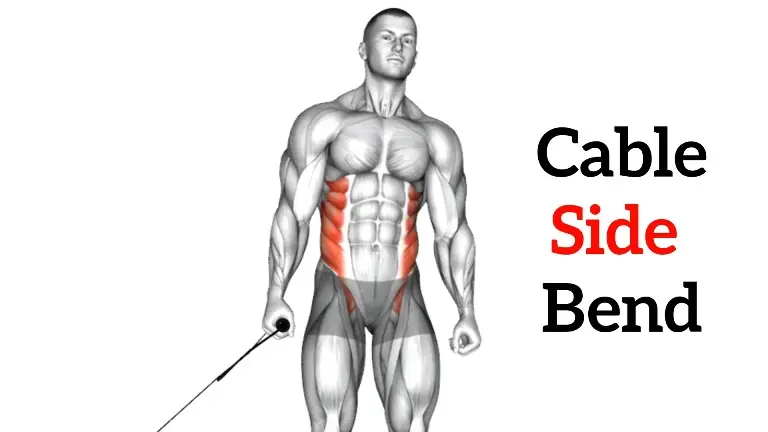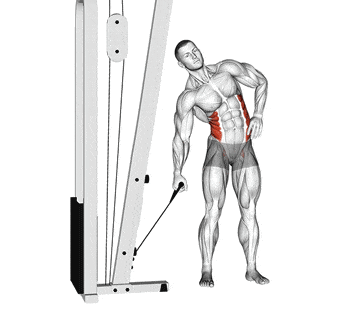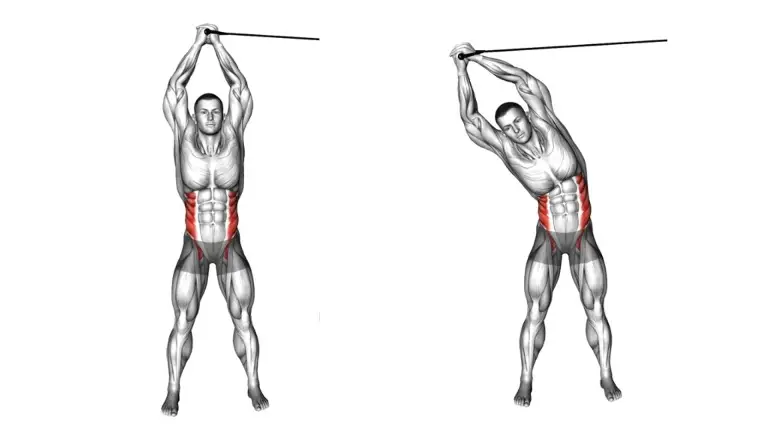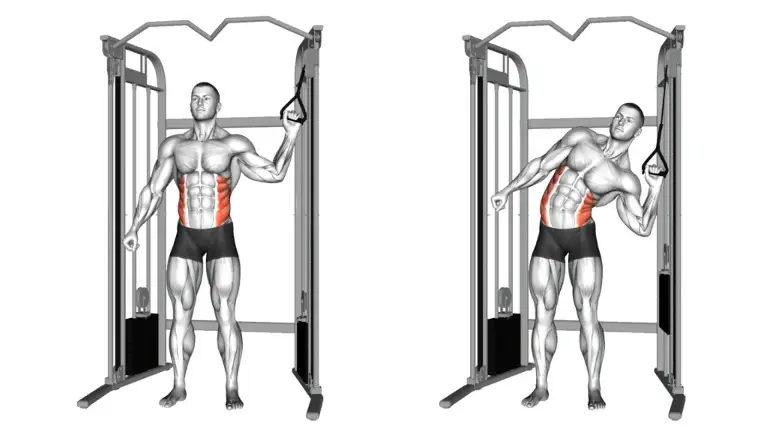If you’re looking for an oblique exercise to include in your gym workout plan, practice cable side bends.
Cable side bends are isolation exercises that target muscle groups on the side of your body—specifically the oblique muscles.
When done with the right form and technique, it can help a great deal in increasing the strength of the oblique, and the overall strength and stability of the core.
In this article, we will discuss how to do cable side bends. We will also discuss the various cable side bends benefits.

- What Is Cable Side Bend
- Cable Side Bend Muscles Worked
- How To Do Cable Side Bend
- Proper Form And Tips
- Benefits of Side Bend
- Cable Side Bend Variations
- Overhead cable side bend
- Single Arm high-cable side bend
- Alternatives to Cable Side Bends
- 1. Dumbbell Side Bend
- 2. Side Plank
- 3. Alternate Heel Touches
- FAQs
- Are cable side bends good?
- What do cable side bends work?
- Takeaways
What Is Cable Side Bend
The cable side bends effectively target the internal and external obliques, strengthen the lateral flexion of your spine, improve spinal mobility, and help to develop a strong and stable core.
- For an easier variation, you can do a bodyweight side bend.
- Use a cable machine for the challenging side bend oblique exercise variation.
The cable side bend is simply a variation of the side bend typically performed using a pulley machine.
Cable side bends are easier to do. You can do more with less weight, so your obliques can move freely.
Using cables allows you to change the point where the load is maximized.

Know More Body Fat %: Use Our Free Body Fat Calculator
Cable Side Bend Muscles Worked
The cable side bend works the obliques—the two layers of muscles Obliques, (the external and internal obliques) at each side of the waist.
The side bend doesn’t work just the obliques. It also heavily hits the Abs, Serratus anterior, and quadratus lumborum, the deep, hidden muscle on either side of the lower spine that helps form the rear of the abdominal wall.
How To Do Cable Side Bend
- Attach the D-handle to a low pulley and stand side-on to the weight stack.
- Grasp the D-handle with your right hand and stand with the pulley to your right side.
- Your torso should be laterally flexed (bent sideways) towards the pulley, and your arm should be straight and close to your body.
- Bend your torso away from the pulley, pulling the D-handle upward.
- Slowly lower the D-handle back to the starting position by bending your torso towards the pulley.
- Repeat for the desired number of repetitions.
- Turn around and repeat the cable side bend with your left side.

Know More: 100+ Ways To Lose Weight (Proven Techniques)
Proper Form And Tips
It is crucial to perform exercises with good form, as that helps prevent any injuries and get the maximum benefits out of your workouts. Here is a guide on how to do cable side bends with proper form.
- After an intensive set of side bends, rest two or three minutes before working your other side so that your performance on the latter doesn’t suffer. Alternate the side you work on first from workout to workout.
- Keep the cable close to your side, your elbow very slightly bent, and your hips still.
- To work the oblique muscle, perform these exercises slowly and steadily.
- Avoid loading the heavyweight for this exercise. Large, overdeveloped oblique muscles will make your waist appear bulky.
- The muscles need 48 to 72 hours to do this. So, If you include cable side bends in your routine, do them at least twice weekly on nonconsecutive days.
Benefits of Side Bend
Including cable side bends in your workout routine can have several benefits. The various cable side bends benefits include:
- Side bends bring balance to your entire body. They lengthen the abdominal muscles, hips, and thigh muscles while improving flexibility in the spine.
- It helps to contribute to a stronger core, reduces the risk of back pain, and improves functional movements such as serving a tennis ball or carrying a heavy object on one side of the body.
- Side bends stretch the abdominal muscles and digestive organs. This aids and regulates digestion, elimination, and metabolism.
- Training the oblique muscles will help shape and tone the waistline. It also helps to eliminate the extra fat layer around the waistline.
Related Posts: Most Effective Abs & Oblique Cable Exercises & Workout
Cable Side Bend Variations
Below are the best side bend variations to increase core stability, muscle hypertrophy, and midline control.
Overhead cable side bend
Overhead cable side bend is an exercise that primarily targets the obliques
You can try out overhead side bend variations that may require different types of equipment, (dumbbell, resistance band, kettlebell) or even no equipment at all.

How To Do Overhead Side Bend
- Stand upright with your feet shoulder-width apart and your arms fully extended overhead.
- Take hold of the D-handle with your arms overhead and place one hand clasped over the other.
- Exhale and bend at your side while keeping your arms directly overhead.
- Continue to bend at your side until you cannot do so without rotating your torso.
- Inhale and return to the starting position.
- After all reps are completed, switch sides and repeat the movement.
- Do 10–15 reps on each side.
Single Arm high-cable side bend
One arm high-cable side bend is an exercise targeting the obliques using a cable stack machine. It allows you to train one side at a time, addressing imbalances.

How To Do High Cable Side Bend
- Place the cable at the highest pulley level and connect a standard handle to the tower.
- Stand by your side to the cable setup. Reach up and grab the handle with an underhand grip.
- Pull down the cable until the elbow almost touches your side and the handle is by your shoulder.
- Keep the arm in a static position. Contract oblique to bring the weight down in a side crunch.
- Once you reach your maximum contraction, slowly release the weight back to the starting position.
- The weight stack should never be unloaded in a resting position.
- After all reps are completed, switch sides and repeat the movement.
Alternatives to Cable Side Bends
If you’ve gotten bored with cable side bends or are simply not enjoying them anymore, you can try the following cable side bends alternative exercises.
1. Dumbbell Side Bend
A Dumbbell side bend is the best alternative for a cable side bend. It engages and strengthens your core muscles as well as your lower back.
This exercise helps to tone and tighten your abs and obliques and to trim your waist.
The exercise is a simple core exercise to practice at home.

2. Side Plank
The side plank (oblique plank) is one of the best core exercises for strengthening the oblique and abdominal muscles, which don’t get worked as much during abs exercises such as crunches.
If you’re new to planking, you should master the basic forearm plank before moving on to the side plank variation.

3. Alternate Heel Touches
Alternate heel touches, also known as lying oblique reach, is an at-home workout that targets oblique and involves abs.
It is one of the great oblique exercises that can be done easily by beginner and advanced athletes to activate and grow their midsection.
The exercise mimics other oblique exercises such as the cable side bend and oblique crunch.

FAQs
Are cable side bends good?
Cable side bend is a very effective exercise to train the oblique (side abs). It can also contribute to a stronger core, reduce the risk of back pain, and improve functional movements.
What do cable side bends work?
The cable side bend primarily worked the obliques and core muscles, including the erector spinae and transverse abdominus.
In addition, this exercise also uses the serratus anterior, Quadrats Lumborum, as well as the gluteus maximus and hip flexors.
Takeaways
The side bends with a cable are an effective exercise to build toned obliques.
Perform it with correct form, to strengthen your core muscles and increase their robustness and resistance to injury.
If you have back pain, you want to avoid this exercise. Get treatment to resolve the issues, and then start on the side bend. Meanwhile, the rotary torso machine may be a safe alternative.

Manish brings over 10 years of hands-on experience in weight lifting and fat loss to fitness coaching. He specializes in gym-based training and has a lot of knowledge about exercise, lifting technique, biomechanics, and more.
Through “Fit Life Regime,” he generously shares the insights he’s gained over a decade in the field. His goal is to equip others with the knowledge to start their own fitness journey.
